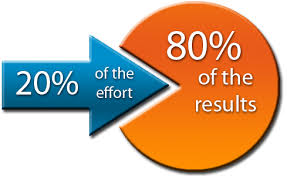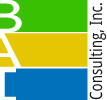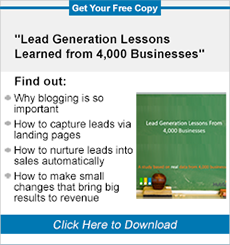As a demand generation marketing consultant, I've been fortunate to work at twice as many tech startups in the last five years, as I did in my first 10 years in technology Sales and Marketing. And I've learned from some of the best and the brightest how to increase market share quickly with a smaller budget and microphone.
It comes down to Pareto's Law: When working on a cost-per-lead model, 20% of your company's marketing activity will bring you 80% of your qualified leads and revenue; Therefore, 80% of your marketing budget can realistically be slashed with little or no effect. This is great news for startups who are working with tight budgets to begin with.

So what is the marketing mix that will bring you the biggest bang for the buck and increase revenue quickly today? The answer to that question surprises a lot of people. But here I tell you what I have seen work at companies who are able to significantly increase revenue with a small marketing budget just by putting their dollars to work in the right areas. The reasoning in this article is backed up with the same results gathered by Hubspot at over 4,000 companies in an educational offer below.
Top Marketing Channels That Will Increase Revenue Today1) Blogging
Blogging drives traffic to your website and establishes you as a thought-leader. Customers that repeatedly come to your blog for advice will realize they need your product or service. Blog articles are a great place to put educational offers and capture warm leads. You must blog properly for SEO by putting keywords in titles, body, alt-tags for graphics, and meta descriptions to come to the top of a search. Page density under a given keyword is what brings you to the top of an organic google search when your prospects are looking for solutions. Blogging is what gives you page density. A lot of companies don't realize this is such an important channel or they don't blog properly for SEO or fail to include educational offers at the bottom of their blog articles.
2) Social Media
Social Media is a great place to push blog articles and educational offers to get the word out. This vehicle educates and lets prospects know about your product or service without them previously knowing your product category even exists. Social Media is two-way communication so you can see what prospects and competitors are saying about your offerings. Whether you are listening or not, they are still out there saying it. It is better to establish your own position via this channel, than let your competitors do it for you obviously.
3) Email Marketing
I have consistently gotten good traction by emailing specific target segments and titles to let them know about offerings that should interest them, so email marketing is definitely part of my cost-effective marketing mix.
4) Marketing Automation: Call-to-Action Buttons, Landing Pages, Lead Nurturing, Lead Scoring, Analytics
This is where you build and improve your online marketing machine. SaaS options for Marketing Automation are Hubspot, Marketo, Eloqua and a bevy of smaller upstarts. Eloqua's minimum license is for 10 people, not practical for smaller companies. Marketo bills itself as an email machine, with automation tools. Hubspot is gaining market leadership because it has more integrated elements for online marketing in addition to email and landing pages, CTA, workflows smart lists like Marketo, it has: Blogging with prompts for proper SEO, Page Grader (for SEO), Keyword Targeting, Competitive Tracking, Social Media integration, and amazing 24/7/365 Support. Hubspot is my SaaS of choice for online marketing because it costs the least and gives you the most tools.
5) Educational Offers aka Content
Absolute necessity to have offers at every level of the sales funnel all over your website, at the bottom of your blog articles, in your email lead nurturing campaigns, and pushed out via email and social media. This is to demonstrate you can solve the customer pain points, prove ROI, and bring prospects 85% of the way down the sales funnel, according to Gartner. These include videos, webinars, ebooks, kits, slide decks, competitive analysis, whitepapers, software trials, case studies, analyst reports proving ROI, and many more possibilities.
Marketing Mix Gray Areas- Use These Elements With Caveats
7) Affiliate Marketing
Affiliate Marketing can be useful to drive traffic to your site having an independent publication list your product and services as a market leader, but wouldn't spend too much time or money on this channel since most companies know this is a recommendation for hire. This channel has the added disadvantage of listing your competitors, so unless you have some solid online marketing going on your website when they get there, they will jump to the next company on the list.
8) Mailers
Packages sent to specific targets to get past gate keepers and draw in attention by decision makers-This is useful and can be expensive but worth it; Must use a clever vehicle that drives the prospect back to your website.
9) Banner Ads
"Banner Ads are the most expensive way to get a lead", according to Howard Ting, Former Director of Marketing at Palo Alto Networks, when we tracked cost-per-lead in the hayday before their very large IPO. Lots of people just get the warm fuzzies seeing their company banner out there, but the actual cost-per-download is prohibitive.
10) Pay-Per-Click
Can be useful to drive traffic, but if you don't have content, you won't convert anyone. PPC has the added downside in that you pay forever, not build up a traffic-driving machine like blogging will, and the minute you stop paying for PPC you have nothing. Without CTAs for Educational offers and Landing Pages, companies have told me they have spent a fortune on PPC and have obtained zero leads from it. I recommend a modest and consistant budget allocation toward PPC.
Cut the Fat Here-Very Low Return-on-Investment (ROI)
11) Trade Shows
I've worked for two companies who had very large IPOs that did one trade show a year.
I'm not saying don't go to tradeshows. What I am saying is they are very expensive and salespeople often tell me the prospects they are meeting at tradeshows are often very far down the sales funnel with other companies. This is because people look for solutions to their pain points using the internet to research all their options today.
I am advocating fewer trade shows and making a bigger splash when you go to one by driving traffic to your booth with emailing ahead, having a charismatic speaker every hour on the hour in the booth, and having sales scan badges of people that collect around the inevitible crowd that gathers to hear the speaker.
I see lots of companies that used to do 6 trade shows a year, say they aren't getting leads, so now they are doing 60 trade shows and still aren't getting leads, but now they are burning money at an astonishing rate. Trade shows have a place in the mix, but not a lot of trade shows, in my opinion.
12) Glossy Mailers
People throw away junk mail today, think google and target keywords, not postage for B2B
13) Cold-Calls
Warm calls are very effective at getting sales to close once a prospect has downloaded several offers, but cold-calling, not so much. Auto-dialers can be used to increase efficiency, but they are still best used to call a list of people who have already clicked or downloaded offers so you know they have some level of interest in your solution, and thus are not "cold calls".
14) Yellow Page Ads
Don't bother, think target keywords in blog articles for organic search via google, and even PPC instead.
15) PR, Newsletters, and Edittorial Calendars
These methods of getting the word out can be time consuming and expensive. They get you nothing in SEO, and Social Media tweets, likes, and shares.
With a newsletter you are compiling info into one big letter, but no one will share it; So it takes more time than a blog article, but gets much less traffic.
With a Press Release, you are sending it out there, via a paid channel and hoping for the best. Ocassionally you may hear that you have a lead that was attributable to a Press Release, but that is rare. PR, Newsletters, and Editorial Submitions are not worth what they once were in a marketing mix before everything was online and searchable. And I've seen plenty of startups thrive without them altogether.
Of course, it would be nice to have a robust budget and participate in every marketing vehicle out there. But I've seen that the top 5 methods outlined above are the fastest way to increase revenue quickly today whether you are on a tight budget or not. The rule of thumb is to only participate in low-cost channels that 1) drive traffic to your website, 2) capture qualified leads, 3) nurture leads towards sales, and 4) can be tracked via analytics for cost-per-lead to determine ROI.
Do you agree? Is it different at your company? Did I miss any of your favorites?
For more evidence to prove the concepts outlined above, download our slide deck below by clicking our Call-to-Action button below:
Bay Area Inbound specializes in creating educational offers, demand generation campaigns, and lead-generation programs to quickly increase revenue for tech companies. We are located in the SF Bay Area. Contact us at Laurie@BayAreaInbound.com or call us at 510-543-7593.
Follow us on our blog at: www.BayAreaInbound.com/blog

